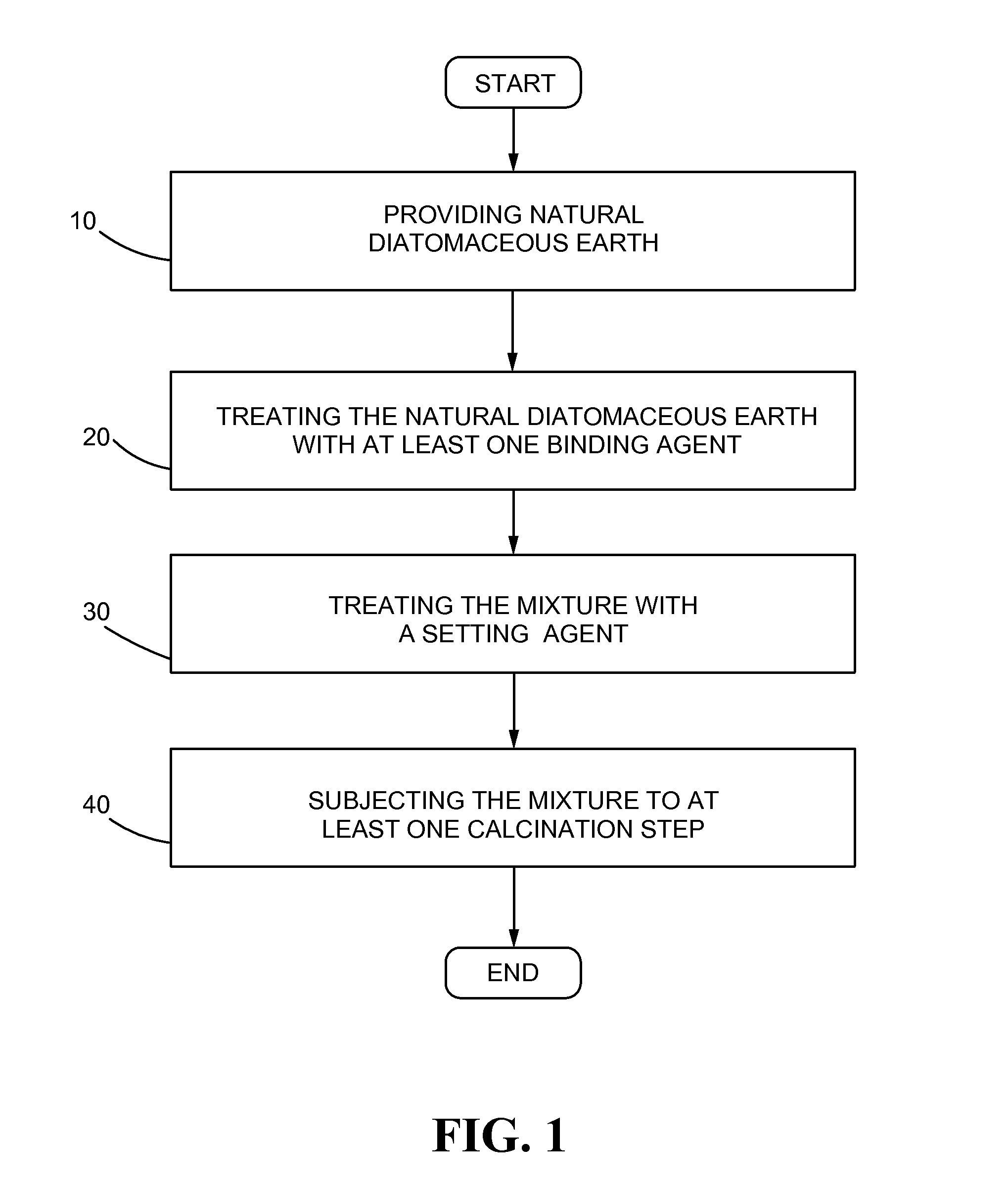Diatomaceous Earth Filter Aid Containing a Low Crystalline Silica Content
- Summary
- Abstract
- Description
- Claims
- Application Information
AI Technical Summary
Benefits of technology
Problems solved by technology
Method used
Image
Examples
example
[0080]X-Ray Fluorescence (XRF) analysis was performed on the Sequoya Ore diatomaceous earth starting material and Sequoya LCS-3 diatomaceous earth starting material using a standard XRF method. The XRF was done before adding binding agents and undergoing the calcination step. Peak intensities from spectra were analyzed by line shape analysis comparison with single element reference spectra. The peak intensities for the diatomaceous earth standard were then converted into pure element count rates that were then used for determination of element composition in samples, by peak intensity analysis and data fitting. Results of the XRF chemical analysis are shown in Table 1. The total metal content by XRF was higher in Sequoya LCS-3 than in Sequoya Ore.
TABLE 1SiO2Al2O3CaOMgONa2OK2OFe2O3(%)(%)(%)(%)(%)(%)(%)Sequoya LCS-385.234.790.490.501.690.431.16Sequoya Ore86.494.290.370.371.400.440.90
examples 1-6
[0081]The un-dried Sequoya Ore was hand milled to about 40 mesh, mixed with either 0% or 5% of binding agent (KASOLV® 16 potassium silicate), then calcined at about 927° C. (1700° F.), about 982° C. (1800° F.), or about 1038° C. (1900° F.) for about 45 minutes. The results obtained from Examples 1-6 are illustrated in Table 2. Table 2 illustrates the effects of varying calcination temperatures and amounts of binding agent on the physical properties and soluble metal properties of the diatomaceous earth products.
[0082]As demonstrated by the results shown in Table 2, diatomaceous earth products were generated having better permeability and crystalline silica content at higher calcination temperatures. It is noteworthy that, when comparing Example 5 and 6, at 1900° F. calcination temperature, the addition of 5% potassium silicate as a binding agent increased the permeability of the product by more than three-fold while only increasing the crystalline silica content by 20%. Without wish...
examples 7-11
[0083]Additional trials using Sequoya LCS-3 starting materials were performed. This material went through a whizzer separator and had some waste removed. The Sequoya LCS-3 had the following particle size distribution: d10 of 3.2 μm, d50 of 11.6 μm, and d90 of 33.5 μm. The crystalline silica content in Sequoya LCS-3 was 0.5 wt %.
[0084]The Sequoya LCS-3 diatomaceous earth starting material was mixed with 0-5% of binding agent (KASOLV® 16 potassium silicate), then calcined at about 1038° C. (1900° F.) for about 45 minutes. The results obtained from Examples 7-11 together with a prior art sample FW14 are illustrated in Table 3. FW14 was made using the standard flux calcination process using sodium carbonate as the flux agent. Table 3 illustrates the effects of varying calcination temperatures and amounts of binding agent on the physical properties and chemical properties of the diatomaceous earth products.
[0085]As demonstrated by the results shown in Table 3, increasing the binding agen...
PUM
| Property | Measurement | Unit |
|---|---|---|
| Temperature | aaaaa | aaaaa |
| Temperature | aaaaa | aaaaa |
| Temperature | aaaaa | aaaaa |
Abstract
Description
Claims
Application Information
 Login to View More
Login to View More - R&D
- Intellectual Property
- Life Sciences
- Materials
- Tech Scout
- Unparalleled Data Quality
- Higher Quality Content
- 60% Fewer Hallucinations
Browse by: Latest US Patents, China's latest patents, Technical Efficacy Thesaurus, Application Domain, Technology Topic, Popular Technical Reports.
© 2025 PatSnap. All rights reserved.Legal|Privacy policy|Modern Slavery Act Transparency Statement|Sitemap|About US| Contact US: help@patsnap.com

